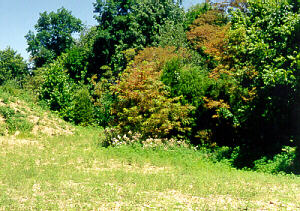
The relationship between leaf area index and microclimate in tropical forest and oil palm plantation: forest disturbance drives changes in microclimate. Global patterns of terrestrial vertebrate diversity and conservation. Atlantic forest bird communities provide different but not fewer functions after habitat loss. BioFrag | Edge response-The BioFrag software. Abundance signals of amphibians and reptiles indicate strong edge effects in Neotropical fragmented forest landscapes. Landscape moderation of biodiversity patterns and processes - eight hypotheses. Predicting biodiversity change and averting collapse in agricultural landscapes. Habitat fragmentation, variable edge effects, and the landscape-divergence hypothesis. Not seeing the ocean for the islands: the mediating influence of matrix-based processes on forest fragmentation effects. Rethinking the conceptual foundations of habitat fragmentation research. Edge effects in central Amazonian forest fragments.

Countryside biogeography of Neotropical reptiles and amphibians. Ecological traits affect the response of tropical forest bird species to land-use intensity. Body size, niche breadth, and ecologically scaled responses to habitat fragmentation: mammalian predators in an agricultural landscape. Energy and interspecific body size patterns of amphibian faunas in Europe and North America: anurans follow Bergmann’s rule, urodeles its converse. Predicting extinction risk in declining species. Multiple causes of high extinction risk in large mammal species. Avian extinctions from tropical and subtropical forests. Life history and spatial traits predict extinction risk due to climate change. Predictors of forest fragmentation sensitivity in Neotropical vertebrates: a quantitative review. Effects of habitat fragmentation and disturbance on howler monkeys: a review. Making statistics biologically relevant in fragmented landscapes. Rethinking patch size and isolation effects: the habitat amount hypothesis. Synergistic interactions between edge and area effects in a heavily fragmented landscape. Pervasive impact of large-scale edge effects on a beetle community. Edge structure determines the magnitude of changes in microclimate and vegetation structure in tropical forest fragments. Habitat Fragmentation and Landscape Change: An Ecological and Conservation Synthesis (Island Press, 2013)ĭidham, R. The environmental legacy of modern tropical deforestation.

Anthropogenic disturbance in tropical forests can double biodiversity loss from deforestation. Multiple edge effects and their implications in fragmented landscapes. Forest fragmentation and matrix effects: the matrix does matter. BIOFRAG - a new database for analyzing BIOdiversity responses to forest FRAGmentation. Habitat fragmentation and its lasting impact on Earth’s ecosystems. Our results highlight the pervasive ability of forest edges to restructure ecological communities on a global scale. Smaller-bodied amphibians, larger reptiles and medium-sized non-volant mammals experienced a larger reduction in suitable habitat than other forest-core species. Species that live in the centre of the forest (forest core), that were more likely to be listed as threatened by the International Union for Conservation of Nature (IUCN), reached peak abundances only at sites farther than 200–400 m from sharp high-contrast forest edges. We show that the abundances of 85% of species are affected, either positively or negatively, by forest edges. Here we assembled a global dataset on species responses to fragmentation and developed a statistical approach for quantifying edge impacts in heterogeneous landscapes to quantify edge-determined changes in abundance of 1,673 vertebrate species. However, predicting these declines is challenging in heterogeneous fragmented landscapes. Forest edges influence more than half of the world’s forests and contribute to worldwide declines in biodiversity and ecosystem functions.


 0 kommentar(er)
0 kommentar(er)
